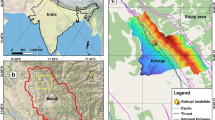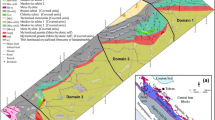Abstract
This study developed a rockfall simulation method based on the actual rock block accumulation size. The terrain data and orthophoto map were obtained based on post-event high-precision UAV aerial image data, and digital image processing methods were used to identify the rock block sizes of rockfall deposits. The sizes of the sedimentary rockfall blocks were recorded in a field survey. The distribution law of the rock block size was compared using field statistics and image recognition. Based on the topographic data and rock block accumulation size, a three-dimensional (3D) particle flow code was used to simulate the deposition process and characteristics of the rockfall. The research results showed that the distance of the rockfall deposit is approximately 480 m and the average width is approximately 86 m. Rockfall deposits were mainly composed of white and gray-white dolomite blocks, which were deposited along the slope in a strip shape with a deposition direction of 142°. The elevation of the upper deposit near the source area was 1290 m, and the elevation difference was 180 m. The rockfall deposit forms the main deposition area, secondary deposition area, and rockfall area. The deposits are mainly composed of small-sized rock blocks, and their rock block size generally obeys the inverse model. Along the stacking direction, the proportion of the small-sized rock blocks shows a decreasing trend. The proportions of medium-sized and large-sized rock blocks show a bimodal situation with two peaks, and the change curve is an irregular “M” shape. The simulation results showed that the slope movement process, from obvious deformation to sedimentation after instability, is about 22.5 s, and the main slip time is about 18.0 s. Along the depth direction, as the depth increases, the composition of small-sized rock blocks increases, while the composition of large-sized and medium-sized rock blocks decreases. However, a reverse granular hierarchical structure appears in the sediments. The research results are consistent with the actual accumulation status of rockfalls, and related research methods provide a reference for quantitative risk assessment of rockfalls.
















Similar content being viewed by others
References
Bi YuZhang, YanJun Du, He SiMing, Sun XinPo, Wang DongPo, Li XinPo, Liang H, Yong Wu (2018) Numerical analysis of effect of baffle configuration on impact force exerted from rock avalanches. Landslides 15(5):1029–1043. https://doi.org/10.1007/s10346-018-0979-z
Borella J, Quigley M, Krauss Z, Lincoln K, Attanayake J, Stamp L, Lanman H, Levine S, Hampton S, Gravley D (2019) Geologic and geomorphic controls on rockfall hazard: how well do past rockfalls predict future distributions?: Natural Hazards and Earth System Sciences, v. 19, no. 10, p. 2249-2280. https://doi.org/10.5194/nhess-19-2249-2019
Deng Q, Gong L, Zhang L, Yuan R, Xue Y, Geng X, Hu S (2016) Simulating dynamic processes and hypermobility mechanisms of the Wenjiagou rock avalanche triggered by the 2008 Wenchuan earthquake using discrete element modelling: Bulletin of Engineering Geology and the Environment, v. 76, no. 3, p. 923–936.https://doi.org/10.1007/s10064-016-0914-2
Fan X, Tang J, Tian S, Jiang Y (2020) Rainfall-induced rapid and long-runout catastrophic landslide on July 23, 2019 in Shuicheng. Guizhou, China: Landslides 17(9):2161–2171. https://doi.org/10.1007/s10346-020-01454-y
Fan X, Xu Q, Scaringi G, Zheng G, Huang R, Dai L, Ju Y (2018) The “long” runout rock avalanche in Pusa, China, on August 28, 2017: a preliminary report: Landslides, v. 16, no. 1, p. 139–154.https://doi.org/10.1007/s10346-018-1084-z
Ge Y, Lin Z, Tang H, Zhong P, Cao B (2020) Measurement of particle size of loose accumulation based on alpha shapes (AS) and hill climbing-region growing (HC-RG) algorithms: sensors (Basel), v. 20, no. 3.https://doi.org/10.3390/s20030883
Grant A, Wartman J, Massey C, Olsen MJ, O’Banion M, Motley M (2017) The impact of rockfalls on dwellings during the 2011 Christchurch. New Zealand, Earthquakes: Landslides 15(1):31–42. https://doi.org/10.1007/s10346-017-0855-2
He K, Yin Y, Li B, Chen C (2019) The mechanism of the bottom-crashing rockfall of a massive layered carbonate rock mass at Zengziyan, Chongqing, China: Journal of Earth System Science, v. 128, no. 4.https://doi.org/10.1007/s12040-019-1141-6
He K, Li Y, Ma G, Xiewen Hu, Liu Bo, Ma Z, Zepeng Xu (2020) Failure mode analysis of post-seismic rockfall in shattered mountains exemplified by detailed investigation and numerical modelling. Landslides 18(1):425–446. https://doi.org/10.1007/s10346-020-01532-1
İnan Sezer G, Ramyar K, Karasu B, Göktepe AB, Sezer A (2008) Image analysis of sulfate attack on hardened cement paste: Materials & Design, v. 29, no. 1, p. 224–231.https://doi.org/10.1016/j.matdes.2006.12.006
Jiang N, Li H-b, Zhou J-W (2021) Quantitative hazard analysis and mitigation measures of rockfall in a high-frequency rockfall region. Bull Eng Geol Env 80(4):3439–3456. https://doi.org/10.1007/s10064-021-02137-1
Liu C, Shi B, Zhou J, Tang C (2011) Quantification and characterization of microporosity by image processing, geometric measurement and statistical methods: application on SEM images of clay materials: Applied Clay Science, v. 54, no. 1, p. 97–106.https://doi.org/10.1016/j.clay.2011.07.022
Liu Z, Su L, Zhang C, Iqbal J, Hu B, Dong Z (2020) Investigation of the dynamic process of the Xinmo landslide using the discrete element method: Computers and Geotechnics, v. 123.https://doi.org/10.1016/j.compgeo.2020.103561
Ma S, Wei J, Xu C, Shao X, Xu S, Chai S, Cui Y (2020a) UAV survey and numerical modeling of loess landslides: an example from Zaoling, southern Shanxi Province, China: Natural Hazards, v. 104, no. 1, p. 1125–1140.https://doi.org/10.1007/s11069-020-04207-1
Ma S, Chong Xu, Xiwei Xu, He X, Qian H, Jiao Q, Gao W, Yang H, Cui Y, Zhang P, Li K, Mo H, Liu J, Liu X (2020b) Characteristics and causes of the landslide on July 23, 2019 in Shuicheng. Guizhou Province, China: Landslides 17(6):1441–1452. https://doi.org/10.1007/s10346-020-01374-x
Matasci B, Stock GM, Jaboyedoff M, Carrea D, Collins BD, Guérin A, Matasci G, Ravanel L (2017) Assessing rockfall susceptibility in steep and overhanging slopes using three-dimensional analysis of failure mechanisms. Landslides 15(5):859–878. https://doi.org/10.1007/s10346-017-0911-y
Nagendran SK, Ismail MAM (2019), Analysis of rockfall hazards based on the effect of rock size and shape: International Journal of Civil Engineering, v. 17, no. 12, p. 1919-1929.https://doi.org/10.1007/s40999-019-00418-1
Ren Z, Wang K, Yang K, Zhou Z-H, Tang Y-J, Tian L, Xu Z-M (2018) The grain size distribution and composition of the Touzhai rock avalanche deposit in Yunnan, China: Engineering Geology, v. 234, p. 97–111.https://doi.org/10.1016/j.enggeo.2018.01.007
Rossato S, Ivy-Ochs S, Martin S, Viganò A, Vockenhuber C, Rigo M, Monegato G, De Zorzi M, Surian N, Campedel P, Mozzi P (2020) Timing, drivers and impacts of the historic Masiere di Vedana rock avalanche (Belluno Dolomites, NE Italy): Natural Hazards and Earth System Sciences, v. 20, no. 8, p. 2157-2174. https://doi.org/10.5194/nhess-20-2157-2020
Ruiz-Carulla R, Corominas J, Mavrouli O (2015) A methodology to obtain the block size distribution of fragmental rockfall deposits. Landslides 12(4):815–825. https://doi.org/10.1007/s10346-015-0600-7
Ruiz-Carulla R, Corominas J, Mavrouli O (2016), A fractal fragmentation model for rockfalls: Landslides, v. 14, no. 3, p. 875–889.https://doi.org/10.1007/s10346-016-0773-8
Sarro R, Riquelme A, García-Davalillo J, Mateos R, Tomás R, Pastor J, Cano M, Herrera G (2018) Rockfall simulation based on UAV photogrammetry data obtained during an emergency declaration: application at a cultural heritage site: Remote Sensing, v. 10, no. 12.https://doi.org/10.3390/rs10121923
Singh PK, Kainthola A, Panthee S, Singh TN (2016) Rockfall analysis along transportation corridors in high hill slopes: Environmental Earth Sciences, v. 75, no. 5.https://doi.org/10.1007/s12665-016-5489-5
Topal T, Akin MK, Akin M (2011) Rockfall hazard analysis for an historical Castle in Kastamonu (Turkey): Natural Hazards, v. 62, no. 2, p. 255–274.https://doi.org/10.1007/s11069-011-9995-1
Verma AK, Sardana S, Sharma P, Dinpuia L, Singh TN (2019) Investigation of rockfall-prone road cut slope near Lengpui Airport, Mizoram, India: Journal of Rock Mechanics and Geotechnical Engineering, v. 11, no. 1, p. 146-158.https://doi.org/10.1016/j.jrmge.2018.07.007
Wang Y-F, Cheng Q-G, Shi A-W, Yuan Y-Q, Qiu Y-H, Yin B-M (2019) Characteristics and transport mechanism of the Nyixoi Chongco rock avalanche on the Tibetan Plateau, China: Geomorphology, v. 343, p. 92–105.https://doi.org/10.1016/j.geomorph.2019.07.002
Wasowski J, McSaveney MJ, Pisano L, Del Gaudio V, Li Y, Hu W (2021) Recurrent rock avalanches progressively dismantle a mountain ridge in Beichuan County, Sichuan, most recently in the 2008 Wenchuan earthquake: Geomorphology, v. 374.https://doi.org/10.1016/j.geomorph.2020.107492
Wei L-W, Chen H, Lee C-F, Huang W-K, Lin M-L, Chi C-C, Lin H-H (2014) The mechanism of rockfall disaster: a case study from Badouzih. Keelung, in Northern Taiwan: Engineering Geology 183:116–126. https://doi.org/10.1016/j.enggeo.2014.10.008
Xing A, Yuan X, Qiang Xu, Zhao Q, Huang H, Cheng Q (2016) Characteristics and numerical runout modelling of a catastrophic rock avalanche triggered by the Wenchuan earthquake in the Wenjia valley. Mianzhu, Sichuan, China: Landslides 14(1):83–98. https://doi.org/10.1007/s10346-016-0707-5
Youssef AM, Pradhan B, Al-Kathery M, Bathrellos GD, Skilodimou HD (2015) Assessment of rockfall hazard at Al-Noor Mountain, Makkah city (Saudi Arabia) using spatio-temporal remote sensing data and field investigation: Journal of African Earth Sciences, v. 101, p. 309–321.https://doi.org/10.1016/j.jafrearsci.2014.09.021
Žabota B, Repe B, Kobal M (2019) Influence of digital elevation model resolution on rockfall modelling: Geomorphology, v. 328, p. 183–195.https://doi.org/10.1016/j.geomorph.2018.12.029
Žabota B, Kobal M (2020) A New methodology for mapping past rockfall events: from mobile crowdsourcing to rockfall simulation validation: ISPRS International Journal of Geo-Information, v. 9, no. 9.https://doi.org/10.3390/ijgi9090514
Zhang M, Lizhou Wu, Zhang J, Li L (2019) The 2009 Jiweishan rock avalanche, Wulong, China: deposit characteristics and implications for its fragmentation. Landslides 16(5):893–906. https://doi.org/10.1007/s10346-019-01142-6
Zhang Y, Xing A, Kaiping Jin Yu, Zhuang MB, Shimin Xu, Zhu Y (2020) Investigation and dynamic analyses of rockslide-induced debris avalanche in Shuicheng. Guizhou, China: Landslides 17(9):2189–2203. https://doi.org/10.1007/s10346-020-01436-0
Zheng D, Frost JD, Huang RQ, Liu FZ (2015) Failure process and modes of rockfall induced by underground mining: a case study of Kaiyang Phosphorite Mine rockfalls: Engineering Geology, v. 197, p. 145–157.https://doi.org/10.1016/j.enggeo.2015.08.011
Zhu Y, Xu S, Zhuang Y, Dai X, Lv G, Xing A (2019) Characteristics and runout behaviour of the disastrous 28 August 2017 rock avalanche in Nayong, Guizhou, China: Engineering Geology, v. 259.https://doi.org/10.1016/j.enggeo.2019.105154
Zhuang Yu, Qiang Xu, Xing A (2019) Numerical investigation of the air blast generated by the Wenjia valley rock avalanche in Mianzhu. Sichuan, China: Landslides 16(12):2499–2508. https://doi.org/10.1007/s10346-019-01253-0
Shuangqi P, Qiang X, Huajin L, et al. (2019) Particle size analysis of deposits based on high-precision image recognition[J]. Journal of Engineering Geology, 27(06): 1290-1301
Guang Z (2018) Landslide-debris flow long-range movement distance research [D]. Chengdu University of Technology, Chengdu
Itasca CGI (2002) PFC3D Particle fow code in 3 dimensions
Funding
This study was supported by the Basic Research Program of the Guizhou Provincial Science and Technology Foundation (ZK [2021] Basic 200).
Author information
Authors and Affiliations
Corresponding author
Ethics declarations
Conflict of interest
The authors declare no competing interests.
Additional information
Responsible Editor: Zeynal Abiddin Erguler
Rights and permissions
About this article
Cite this article
Xu, J., Yang, G., Qin, Y. et al. Simulation study of rockfall deposition based on UAV-PCAS-PFC: a case study on the rockfall deposition of Xiaomaopo in Kaiyang County. Arab J Geosci 15, 468 (2022). https://doi.org/10.1007/s12517-022-09740-w
Received:
Accepted:
Published:
DOI: https://doi.org/10.1007/s12517-022-09740-w




